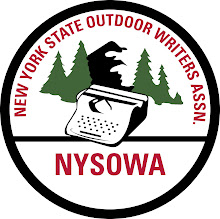By Bob McNitt
If you've been watching the local Central New York news lately, you may have seen segments on coyotes roaming around residential suburban areas. Most recently there have been several reports on the large predator-scavenger canids that are starting to call the DeWitt suburbs home, in the process worrying some about safety issues of having wild animals that size so close to human residences.
I found the reports somewhat ironic since last week's column discussed these and other issues caused by development displacing natural habitat. Reports of wildlife moving into suburban and cluster developed residential areas have been steadily increasing during the past couple of decades. Initially it was primarily deer, but since has seen an increase in other species such as the coyote and more recently black bear.
I fear far too many people today seem to believe that there's a distinctively visible line that separates landscaped developed areas and natural habitat, and that wildlife stays on “its side” of that line. Most farmers learned early on that their crops were a calling card for wildlife and basically accepted that a portion would be annually lost to the opportunistic critters that consumed it. While the herbivores munched on grain and other domestic flora, the predator species often sought out fowl or small livestock such as sheep. Fruit orchards are popular with deer, sheep flocks are popular with coyotes, and free-roaming poultry is a hit with raptor and owl species and smaller predators.
I'm pointing these out since regardless of whether you run a farm or other agricultural endeavor, or simply choose to construct or move to the more rural areas beyond the larger cities limits, the chances are very good that a portion of your new neighbors will be of the furred or feathered kind. And you can bet they'll come visiting, sooner or later.
The steady increase in wildlife in and around these suburban residential areas is somewhat comparable to what we see happen when we put out bird feeders. It doesn't take long for the birds to adapt to the readily available food we offer them, and they keep returning on a regular basis, in the process becoming increasingly less fearful and more tolerant of our presence. Now let's substitute edible shrubbery, bushes, flowers and vegetables for the bird seed …. here come the cottontail rabbits and deer, reacting basically the same as our feathered friends did.
In the case of coyotes, it's just as natural, maybe more so since they are primarily scavengers as well as predators. Residential areas offer them a virtual smorgasbord of food possibilities, from pet food or garbage left outside, to mice, voles and rabbits that often are attracted to the landscaped habitat. Small pets such as cats and the more petite breeds of dogs are also fair game for the coyotes. And like the birds that come to your feeders, they gradually begin to adapt to human presence and that may cause them to become bolder and less fearful of humans, which is probably the case in DeWitt and other problematic areas.
What I'm seeing in recent years is that many species of wildlife are adapting to our changing of the natural habitat, but unfortunately many people aren't adapting to that change in wildlife habits. Stop and consider what happens when you remove all your bird feeders. Without the seed to draw and hold them in your area, the birds disperse to seek food elsewhere.
This same principle applies to other wildlife species – remove the food that attracts them and they'll look elsewhere. The problem in the suburban areas is that too few residents are willing to adopt this approach so the wildlife will continue to prowl the entire neighborhood as long as some food potentials remain. And since the availability of natural habitat food has been substantially decreased due to area displacement, the wildlife will usually continue to seek out residential areas for food.
How quickly wildlife adapts to change is evident to many of us who hunt deer. Prior to the 1970s antlerless deer could only be hunted one day per year – commonly called “doe day” which fell on the last day of the deer hunting season. During the rest of the hunting season, only antlered bucks were legal game. Then in the '60s, the DEC opted to go with group permits which allowed hunters to take a doe or antlerless deer anytime during the open season. Today the permits allow one hunter to take one antlerless deer in addition to an antlered buck.
Prior to the discontinuance of the “doe day,” does were so unaccustomed to being hunted they'd almost walk right up to a hunter. But in just a few years of being hunted throughout the season, they became fully as wary and “hunter-shy” as the bucks. The does adapted and so too have the hunters who once looked down their nose at how “easy” taking a doe could be. Now, if more of the residents complaining about wildlife problems on their property would adapt accordingly, the DEC wouldn't be getting all those calls to “do something” to stop it.

No comments:
Post a Comment